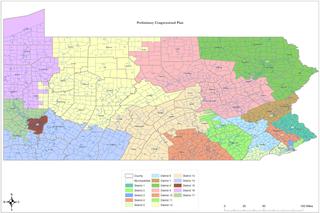This article is part of a yearlong reporting project focused on redistricting and gerrymandering in Pennsylvania. It is made possible by the support of Spotlight PA members and Votebeat, a project focused on election integrity and voting access.
HARRISBURG — The long-awaited redistricting process in Pennsylvania kicked into high gear Wednesday as House Republicans released proposed new congressional districts, but immediate reaction to the initial map was decidedly mixed.
The map was chosen from 19 citizen submissions and was drawn by former Lehigh County Republican Commissioner Amanda Holt. Holt became a well-known redistricting activist a decade ago and was a plaintiff in a successful case against previous state House and Senate maps.
Because of sluggish population growth, Pennsylvania’s next congressional map will have 17 districts, as opposed to the 18 that are evenly represented by Democrats and Republicans.
The new map emphasizes equal population among the districts above all else, which in turn makes them less compact. For example, the proposed District 6 encompasses portions of the state from West Chester to Lebanon County.
In previous testimony before the House State Government Committee, Holt recommended lawmakers embrace “equal population” — with “as close to zero as possible while consistently meeting state goals” — as a core priority. Federal standards dictate that districts should contain an equal number of people, though deviation of up to 1% is understood to be acceptable.
While the map does not split voting precincts, the way it divides some areas of the state — notably the city of Philadelphia and the Harrisburg metropolitan area — has already attracted negative feedback. Hershey, Harrisburg, and Mechanicsburg — all considered part of the same general Central Pennsylvania region — are each in different districts.
“There are some areas that just are really, really troubling and would quickly make it on to the most ugly, ugly districts list,” said Carol Kuniholm of Fair Districts PA, a grassroots group that has long pushed for more transparency in the redistricting process.
Adam Podowitz-Thomas, senior legal strategist from the Princeton Gerrymandering Project, said the map appeared to be fairly competitive upon first look, with seven districts leaning Republican, 5 leaning Democrat, and 5 that will be competitive.
Rep. Seth Grove (R., York), chair of the House State Government Committee, hailed the selection of Holt’s map as a response to public pressure to remove lawmakers from the redrawing process.
“Over the last several months, advocates and everyday Pennsylvanians told us they didn’t want the process of years’ past,” Grove said in a statement. “The people of Pennsylvania asked for increased public involvement, a map that was drawn by people, not by politicians, and the opportunity to offer comment on a preliminary plan before a final vote was taken.”
Grove said his panel will hold an informational hearing Thursday and is expected to vote Monday. A map must be approved by both the GOP-controlled House and Senate before it goes to Democratic Gov. Tom Wolf for consideration, and the Senate is planning to release its own proposal. That means this first map is unlikely to reflect what will be the final outcome.
Redistricting reform advocates said they are grateful that the map has finally been released but are frustrated at how long it took and at the lack of communication throughout the process. Fair Districts PA and the good-government organization Committee of Seventy — which runs the Draw the Lines competition — released their own maps more than a month ago.
“[They could] use the hearings that they already held, but put maps in front of people and give them the ability to kick the tires on the maps,” said David Thornburgh, president of the Committee of Seventy. “It’s a wasted opportunity because now time is short.”
A spokesperson for House Majority Leader Kerry Benninghoff (R., Centre) said “using a citizen-submitted map as a starting point is a logical extension” of the “transparent” process House Republicans have led thus far.
Any changes made going forward will reflect information derived from a public meeting with Holt scheduled for Thursday, past hearings held across the state, and ongoing feedback, the spokesperson, Jason Gottesman, continued.
Rep. Scott Conklin, the ranking Democrat on the House State Government Committee, told Spotlight PA he did not have any input on the map selection.
“I have just seen the map,” he said Wednesday afternoon. “We actually asked if we could have a testifier on a Zoom meeting tomorrow and were denied.”
“I had high hopes and I can’t express my disappointment that it wasn’t done in a bipartisan way,” Conklin added.
The Senate, meanwhile, is expected to consider its own map.
Republican David Argall and Democrat Sharif Street — who lead the Senate State Government Committee — plan to release a joint map next week and hold a vote in January, a spokesperson for Senate Democrats said.
During the redistricting cycle a decade ago, Republicans controlled both the executive and legislative branches.
In 2011, legislative Republicans unveiled the congressional map in public for the first time in December that year. Gov. Tom Corbett signed off on the plan less than 10 days later.
That map was thrown out several years later by the state Supreme Court, which found it was drawn to give Republicans an unfair advantage.
This time around, GOP lawmakers must seek a consensus with Wolf, a Democrat, if they want to avoid the high court.
See the map below or here.

WHILE YOU’RE HERE… If you learned something from this story, pay it forward and become a member of Spotlight PA so someone else can in the future at spotlightpa.org/donate. Spotlight PA is funded by foundations and readers like you who are committed to accountability journalism that gets results.
